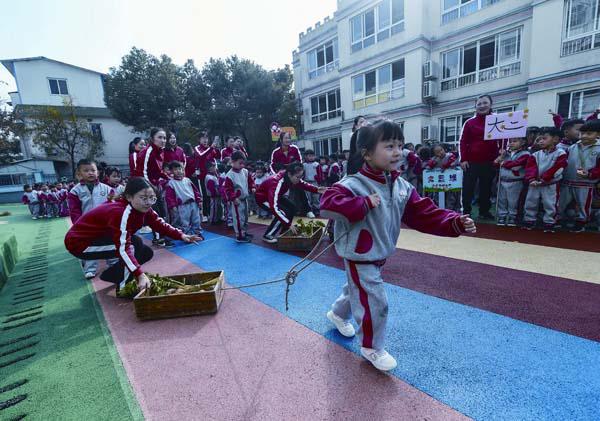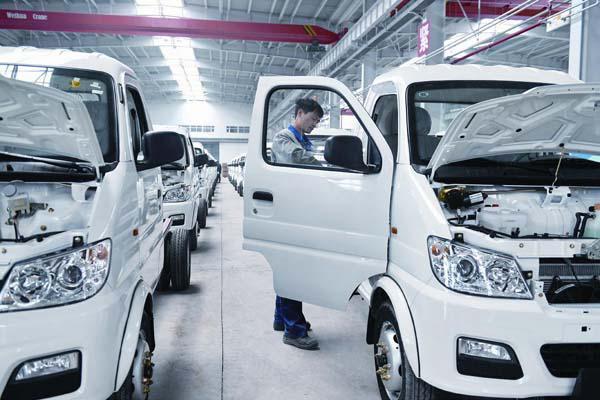Warm for Winter

A farmer covers kumquat trees with plastic fi lm in Rongan County, south Chinas Guangxi Zhuang Autonomous Region, to guard them against the cold and rainy weather on November 13.
Xinjiang Cultural Protection
The State Council Information Offi ce issued a white paper on cultural protection and development in Xinjiang Uygur Autonomous Region on November 15.
Ethnic cultures in Xinjiang are part of Chinese culture, as different ethnic cultures have integrated with each other, constituting a legacy shared by the Chinese nation that has brought into being a splendid Chinese culture, the white paper said.
Since the Peoples Republic of China was founded in 1949, the Chinese Government has attached great importance to documenting and protecting the extraordinary traditional ethnic cultures in the autonomous region and ensuring that they are passed on to succeeding generations, it said.
Vaccine Law
Chinas State Administration for Market Regulation published a draft law on vaccine management on its website on November 11 to solicit public opinions for half a month.
The 11-chapter draft law stipulates that supervision and management of vaccine market access should be tightened.
The draft law requires stricter management of vaccine production, research after sales, distribution and vaccination.
Illegal acts, including fabrication of data, will be severely punished.
Those who participate in illegal acts, shield or connive with violators, hide facts through fabrication, or impede an investigation will receive severe punishment.
Self-Media Overhaul
China has launched a campaign to crack down on illicit activities, including spreading rumors or pornographic information, on social media.
More than 9,800 self-media accounts—subscription-based accounts popular on WeChat, Weibo or news portals such as Toutiao—have faced punishment during the campaign launched on October 20, according to the Cyberspace Administration of China (CAC).
The violations included defaming heroes, tarnishing the nations image, spreading rumors and information that was sensational, lewd or pornographic, and blackmailing companies with media exposure, said the administration.
“Self-media should never be outside judicial reach,” it said.
The CAC summoned social media platforms, including Tencents WeChat and Sina Weibo, warning them against neglecting their duty to manage the self-media on their platforms.
The administration said the overhaul of self-media and its orderly development needs participation by whole society. Supervision and public tip-offs on illegal and harmful information are welcome in order to safeguard a healthy cyberspace.
Optimistic Country
China is the most optimistic country in the world, with 91.4 percent of its citizens saying they believe their country will become a better place in the next decade, according to a report released on November 12.
The report, Priorities of Progress: Understanding CitizensVoices, released by the Economist Intelligence Unit (EIU) on November 12, was based on a global survey of 50 countries to examine how citizens feel about their countrys progress.
The study indicated a more general positive outlook in the emerging markets of Asia and Africa than Organisation for Economic Co-operation and Development countries, primarily made up of developed countries. Besides China, more than 70 percent of respondents in Indonesia and Viet Nam said they think their country is moving toward a better society; while the number in the United States was only 38 percent, with Germany and Italy even lower at 12 percent.
The report also showed that developing countries are increasingly embracing science and technology for a better future. India and China have a strong science and technology ecosystem in areas like artifi cial intelligence and digitization, while leapfrog innovation is helping people across Africa overcome infrastructure constraints.
The percentage of respondents who strongly agreed that technology has changed society for the better is the largest in South Africa(38 percent), Indonesia (34 percent) and Thailand and Viet Nam (both 32 percent), compared with only 5.7 percent in Canada, 6.9 percent in Germany and 11 percent in South Korea.
Moreover, the survey found that healthcare remains the top priority, followed by social protection, access to education, public order, transport infrastructure and the environment.
Winner Takes All
Children pull crops and vegetables during an amusing sports event at the Central Kindergarten in Changxing County, east Chinas Zhejiang Province, on November 13.
Publishing Industry
Chinas publishing industry has grown rapidly over the past four decades, with the number of publishing houses increasing from 105 to over 580, data from the National Press and Publication Administration(NPPA) showed.
In 2017 alone, nearly 500,000 varieties of books were published, compared with 15,000 in 1978. A total of 9.24 billion copies were printed, generating a total sales volume of 370.4 billion yuan ($53.5 billion), according to the NPPA.
Since reform and opening up, Chinas publishing industry has evolved in areas of management, ownership, cultural products and services, and integration with other sectors, said NPPA offi cial Liu Xiaokai at an event commemorating the publishing industrys development.
Brick and mortar bookstores in China have taken the path of integrated development and trans- formation and upgrading, thanks to favorable policies introduced in recent years, said Liu.
Ai Limin, Director General of the Books and Periodicals Distribution Association of China, said that it has become a mainstream trend for bookstores to promote the integration of online and offl ine stores.
Multiple publishing patterns, including traditional print publishing and emerging electronic, digital, Internet and big data publishing, have changed the way people read.
Director General of the Publishers Association of China Liu Binjie suggested that the publishing industry adopt advanced technologies to foster a new reading mode.
Li Guoqing, founder of ecommerce platform Dangdang.com, pledged to make efforts in the areas of original online content, e-books, videos and audio books in the next three years.
Sharing Wheelchairs
A patients relative scans the QR code of a shared wheelchair with a smartphone at the Gansu Provincial Maternity and Childcare Hospital in Lanzhou, northwest Chinas Gansu Province, on November 13.
5G on Bridge
The Hong Kong-Zhuhai-Macao Bridge, the worlds longest sea bridge, is expected to have 5G service in the future, according to Fang Zheng, Vice General Manager of the WLAN offi ce of ZTE Corp., the bridges network operator.
The 55-km bridge, which opened in October, connects the mainland province of Guangdong with Hong Kong and Macao special administrative regions.
“Experts and workers have overcome the diffi culties of a complex construction environment and the lack of optical fi ber to provide tailored 4G solutions for the bridge and are preparing for the upgrading to 5G service,” said Fang.
The crew extended the coverage area of the optical fi ber to 20 km, double the conventional maximum onshore coverage, to ensure full network signal coverage along the bridge.
“The Hong Kong-Zhuhai-Macao Bridge is a unique application of wireless technology, highlighting the high-quality products and advanced technology provided by Chinas communication sector,” said Fang.
The bridge is now ready to access the Internet of Things, a major business goal of 5G technology. From the very beginning of construction, the technological base needed for 5G was considered in terms of network architecture, room for 5G stations and the installment of optical fi ber, Fang said.
Level Playing Field
China will step up efforts to ease market restrictions for foreign investment, with measures to open up more sectors and guarantee equal treatment, according to a press conference on November 9.
Tang Wenhong, an offi cial with the Ministry of Commerce, said the ministry will set an agenda to implement policies designed to improve the business environment and encourage foreign investment.
By the end of March 2019, the government will eliminate all limits that go beyond the offi cial negative list for foreign investment and a special inspection will be launched to ensure all foreign-funded fi rms are treated equally in government procurement, subsidies and licenses.
By the end of this year, provin- cial authorities will establish and improve mechanisms to handle complaints from foreign businesses.
All laws, rules and normative documents that go against the current opening-up policy will be scrapped by the end of 2019. From services to manufacturing and telecommunications, more sectors will become open to foreign businesses and the investment environment will improve, Tang said.
A string of policies have already been announced to improve the business environment, including building a level playing fi eld, strengthening intellectual property protection and reducing business operation costs.
Xiong Maoping, an offi cial from the State Administration for Market Regulation, said steps will be taken to make market entry easier and transparent. “By the end of the year, the time required for opening a business will be cut to 8.5 days in major cities,” Xiong said.
Zhou Xiaofei from the National Development and Reform Commission said the Central Government will pilot an evaluation system for the business environment in major cities in 2019 and promote the program nationwide in 2020.
The evaluation system will rank cities in three areas: corporate life cycles, attractiveness to investors and high-quality development.
Riding the Tide
A visitor tries out a virtual reality ride at the 20th China Hi-Tech Fair in Shenzhen, south Chinas Guangdong Province, on November 14. The fair saw participants from over 40 countries and international organizations and displayed more than 1,000 new products and technologies.
Aiding Enterprises
Chinas top securities regulator has emphasized the role of the capital market in supporting Internet companies.
At a recent forum on fi nancial capital and Internet technology innovation, Fang Xinghai, Vice Chairman of the China Securities Regulatory Commission, said the diffi culties in applying for initial public offerings (IPOs), which plagued enterprises for years, have been resolved. The time to get IPO approval has been reduced to less than nine months from three years.
More than 500 enterprises raised about 355.4 billion yuan ($51 billion) through IPOs from 2017 to October 2018, Fang said.
The commission is also pushing forward mergers and acquisitions(M&As;), mainly between upstream and downstream companies in the same industry to ensure industrial improvement through reorganization.
Chinas securities market saw 5,765 M&As; from 2017 to September 2018, with transactions reaching 3.67 trillion yuan ($527 billion).
The commission is encouraging micro, small and medium-sized enterprises to debut on Chinas National Equities Exchange and Quotations (NEEQ), also known as the new third board, created to support innovative and fast-growing enterprises.
Qualifi ed companies in China can apply to list on NEEQ through brokerage fi rms, with no restriction on their ownership, industries and profi tability.
From 2017 to September 2018, NEEQ-listed companies raised about 181.2 billion yuan ($26 billion) through issuing shares.
Medicine Export
Chinese pharmaceutical companies boosted their exports to the United States at an exhibition in Las Vegas on November 8-9, with an actual transaction of more than $2.3 million.
It was the second edition of the China Pharmaceutical Ingredients Brand Pavilion, which selected 63 enterprises from 20 provinces. The 800-square-meter Chinese pavilion was put up at Supplyside West, one of the top conventions in the international healthcare ingredients industry, which gathered more than 1,600 exhibiting companies from all over the world.
According to the China Chamber of Commerce for Import and Export of Medicines and Health Products, Chinese exhibitors received more than 3,000 professional customers. Around 80 percent were American buyers.
Wang Maochun, Vice President of the China Chamber of Commerce for Import and Export of Medicines and Health Products, said Chinese medicine has received special attention and recognition from the international healthcare market in recent years.
“The United States is the primary export market for plant extract products of China. From 2013 to 2017, Chinas exports of plant extracts to the United States totaled $8.86 billion with an average compound annual growth rate of nearly 15 percent,” Wang said.
Getting Mileage
A worker assembles sanitation vehicles in a workshop of a Beijing-headquartered company in Laoting County, north Chinas Hebei Province, on November 11. The coordinated development of the Beijing-Tianjin-Hebei region has benefi ted the county, which is home to over 50 projects in equipment manufacturing, new energy and medicine that have been relocated from Beijing and Tianjin since 2014.
Tax Collaboration
A senior Chinese taxation offi cial has called for strengthened cooperation among taxation authorities of Asian and Oceanian regions to smooth trade and investment in the face of increasing challenges.
“We should jointly improve modern taxation policies and collection systems... and support each other in promoting economic stability and sustainable development in the Asia-Pacifi c region,” Wang Jun, head of the State Administration of Taxation, said at the annual meeting of the Study Group on Asian Tax Administration and Research(SGATAR) that opened in Hangzhou, east Chinas Zhejiang Province, on November 13.
Wang urged SGATAR members to share successful experiences, expand taxation reform in an open and inclusive manner, and work to lower tariff barriers.
The Chinese Government is stepping up taxation reforms to build a better business environment. Separated national and local taxation systems are being unifi ed for higher effi ciency. Value-added tax rates were reduced to help the real economy. New individual income tax and environmental protection tax have also been put into effect.
Naomi Ferguson, Chief Executive and Commissioner of the New Zealand Inland Revenue Department, spoke highly of Chinas moves during the conference, saying she expected closer cooperation between the two countries. This year marks the 10th anniversary of the China-New Zealand Free Trade Agreement.
Finding a Common Thread

Women embroiders in Chengwang Village, southwest Chinas Guizhou Province, on November 13. The local government is encouraging women to use their embroidery skills to generate incomes. Traditional handicrafts can be sold as tourist souvenirs to help villagers shake off poverty.
Solid Waste
Chinas solid waste imports slumped in the fi rst 10 months of 2018 as the government stepped up enforcement of a ban on solid waste imports.
Imports of plastic, paper and metal waste totaled 17.27 million tons in the January-October period, down 51.5 percent from the same period last year, according to the General Administration of Customs. In October alone, solid waste imports amounted to 1.64 million tons.
Solid waste began to be imported as a source of raw materials in the 1980s. For years, China has been the worlds largest importer of the category, despite its weak garbage disposal capacity. Also, some companies illegally bring foreign waste into the country for profi t, posing a threat to the environment and public health.
Given rising public awareness and Chinas green development drive, the government last year decided to phase out such imports by 2019, except for those containing resources that are not substitutable.
The government has banned imports of 24 types of solid waste, including plastics and paper, and has imposed tough quality restrictions on other recyclable materials.

